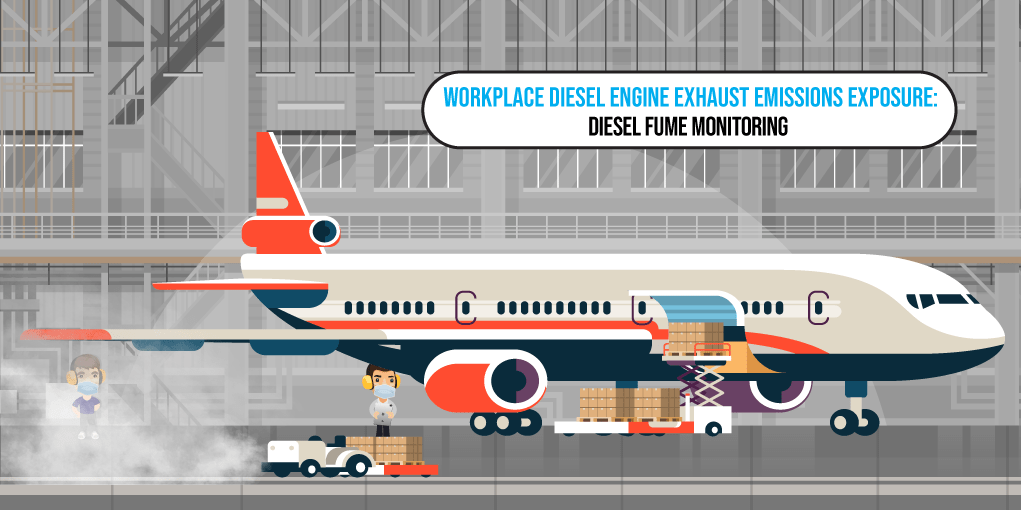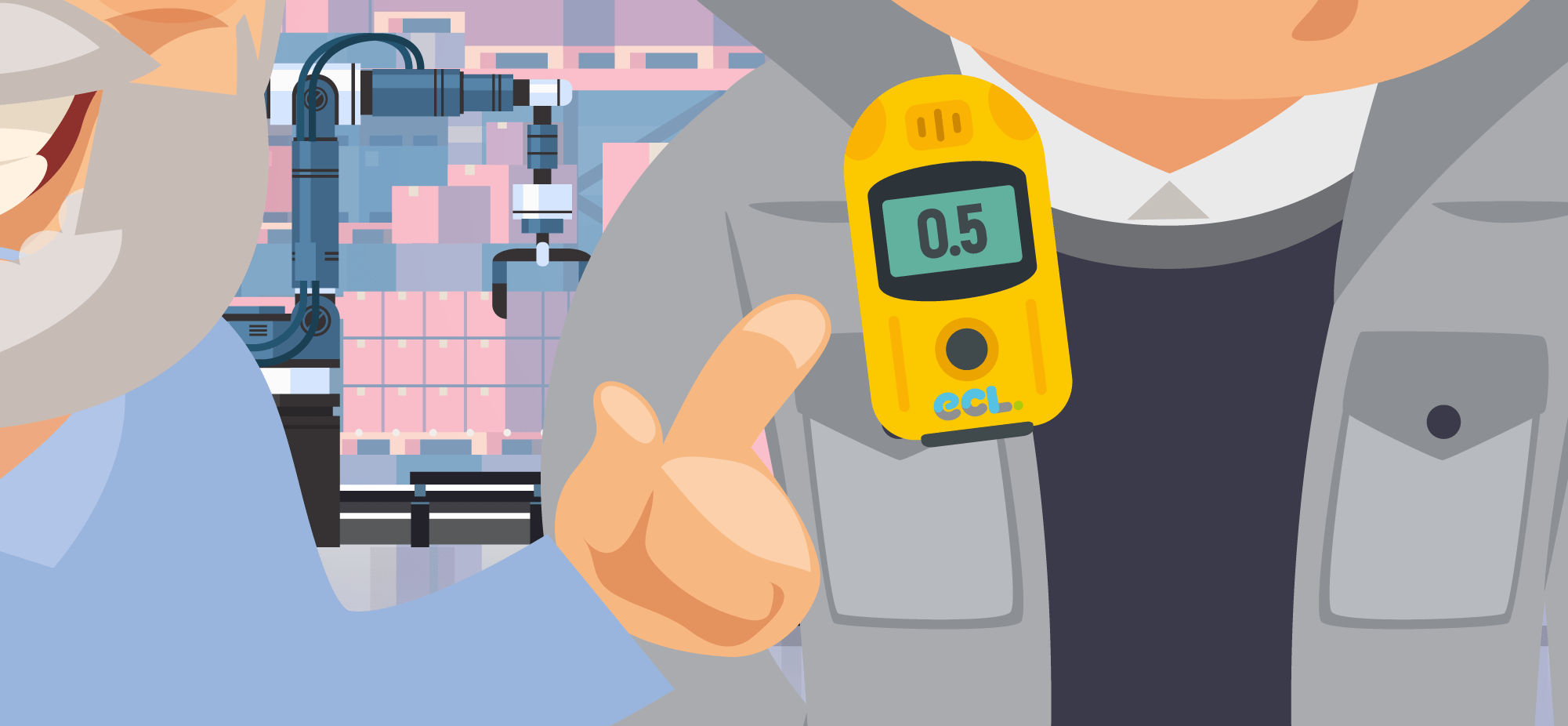Diesel Fume Monitoring is essential in the fast-paced world of industrial growth, as the effects of diesel fumes exposure is significant with diesel engines and in turn diesel engine exhaust emissions (DEEE) playing such a pivotal role in various sectors, from transportation to construction and beyond.
The emissions produced by these diesel engines present a very serious concern for workplace health and occupational safety.
Addressing DEEE exposure has become a crucial aspect of maintaining a safe and healthy work environment.
This article explores what diesel engine exhaust emissions are, the associated health risks, current UK regulations, the diesel fumes exposure limits, how we assess the risk of diesel fumes exposure, conduct diesel fume monitoring and implement DEEE exposure control measures.

What Are Diesel Engine Exhaust Emissions?
Diesel Engine Exhaust Emissions refer to the complex mixture of vapours, gases, fumes and particles released into the air when diesel fuel is burned in internal combustion engines. These are most common in cars, trucks, trains, buses, and ships, as well as more stationary equipment like power generators and pumps.
For example, you may experience increased diesel fume exposure if you live or work near heavy industrial vehicles or motor vehicles entering/exiting car parks, transport stations, garages, attractions or stadiums.
Workers on construction sites are especially exposed to potentially harmful diesel fumes as they often use diesel operated plant and equipment.
Diesel fuel is a necessary part of all our day to day lives, however, there are numerous health risks associated with such diesel exhaust emission exposure.
In total, there are more than 20+ chemicals suspected or proven to cause cancer that have been found in diesel exhaust emissions.
The exact composition of these emissions however cannot be completely calculated as it can vary considerably depending on the fuel used, engine type, operating conditions, and if any emission control systems are installed/practiced.
A selection of the main harmful substances contained within DEEE can include:
- Nitrogen Oxides (NOx): NOx gases, primarily nitric oxide (NO) and nitrogen dioxide (NO2), are produced when the high temperature in the diesel engine’s combustion process causes nitrogen and oxygen in the air to react.
- Particulate Matter (PM): Particulate matter consists of tiny particles suspended in the air, including both fine particles (PM2.5) and larger particles (PM10). These particles can contain various substances, such as carbon, organic compounds, metals, and other pollutants.
- Carbon Monoxide (CO): Carbon monoxide is produced when carbon in the diesel fuel is not completely burned. CO is a colourless, odourless gas that can interfere with the body’s ability to transport oxygen, leading to health issues, particularly in enclosed spaces.
- Hydrocarbons (HC): Diesel engines emit hydrocarbons, which are unburned fuel compounds. These compounds can contribute to the formation of ground-level ozone and smog and may have carcinogenic properties.
- Sulphur Dioxide (SO2): If the diesel fuel contains sulphur, it can lead to the release of sulphur dioxide upon combustion. SO2 contributes to respiratory issues and can also contribute to the formation of acid rain.
- Volatile Organic Compounds (VOCs): VOCs are a group of organic compounds that can evaporate into the air and contribute to air pollution. Some VOCs emitted from diesel engines can react with other pollutants to form ground-level ozone and smog.
Why Reduce DEEE Exposure? The Effects of Diesel Fumes.
The exposure to diesel engine exhaust emissions can have various health and environmental consequences.
DEEE exposure can cause a wide range of adverse health effects on individuals, particularly those who work in industries where diesel engines are prevalent.
The complex mixture of gases and particles present in diesel exhaust emissions pose various risks to the respiratory and cardiovascular system, potentially leading to both short-term and long-term health issues.
Short-term effects of diesel fumes include irritation of the eyes, nose, and throat, as well as dizziness and headaches.
Prolonged exposure to DEEE has been linked to more serious health issues, such as respiratory diseases like asthma, chronic obstructive pulmonary disease (COPD), and lung cancer. It can also exacerbate existing respiratory conditions and lead to cardiovascular issues such as heart attacks and strokes.
Diesel engine exhaust emissions containing diesel particulate matter (DPM), has been classified as carcinogenic to humans by the International Agency for Research on Cancer (IARC). It’s linked to an increased risk of lung cancer, particularly among workers exposed to high levels of DEEE, such as bus drivers, truck drivers, heavy equipment operators, and miners.
There is also evidence to suggest that exposure to DEEE may have adverse effects on fetal development and could impact male fertility and reproductive health.
Emerging research indicates that there could also be potential links between DEEE exposure and cognitive impairment and neurodegenerative disorders such as Alzheimer’s and Parkinson’s diseases.
Diesel exhaust emissions can also contribute to environmental air pollution, by degrading air quality and contributing to the formation of smog. This can in turn impact surrounding local ecosystems.
Given the diverse health and environmental risks associated with diesel engine exhaust emissions exposure, it is essential for individuals working in industries with high DEEE concentrations to take necessary precautions.
Employers should implement effective DEEE control measures, such as Local Exhaust Ventilation (LEV), use adequate Personal Protective Equipment (PPE), conduct regular diesel fume monitoring, and adhere to all regulatory standards, to mitigate the risks of exposure.
Additionally, regular health monitoring and awareness about the potential hazards of DEEE exposure in environments where staff are most at risk are crucial for protecting workers’ health and well-being.
What Are The Diesel Fumes Exposure Symptoms?
Exposure to Diesel Engine Exhaust Emissions can lead to various side effects and symptoms, depending on the duration and intensity of exposure.
Diesel fumes exposure symptoms may manifest immediately after exposure or develop over time with prolonged or repeated exposure.
The most common symptoms associated with diesel fumes exposure are very flu-like, including shortness of breath, coughing or wheezing, chest tightness and sore throat.
It can also cause eye and throat irritation, including redness or a burning sensation of the eyes and sore throat to nausea and dizziness.
Skin irritation and redness of the skin is another common symptom, particularly in the areas exposed to DEEE.
Diesel fumes exposure is also known to cause some neurological symptoms such as difficulty concentrating, memory problems, confusion and mood changes.
More uncommon diesel fumes exposure symptoms include a rapid heartbeat, chest discomfort, an upset stomach, vomiting and diarrhoea.
It is advised to see a doctor if you show any of these symptoms which could also be caused by several different factors not associated with diesel fume exposure.
Which Industries Require Diesel Fume Monitoring?
Diesel engine exhaust emissions exposure monitoring is imperative in various industries where diesel engines are used.
It’s commonly believed that the highest risk of diesel exhaust emissions exposure is to residents located in and around towns and cities from busy roads and popular transport routes, but it is in fact the workforce in occupational settings that face the highest exposure risks.
Here are some key industries that require diesel fume monitoring:
- Road Transport Workers
- Rail Transport Workers
- Aviation Workers
- Fast Food Drive Thru Workers
- Maritime Industry
- Construction Workers
- Mining Operators
- Manufacturing Facilities
- Industrial Facilities
- Farmers
- Warehouse Workers
- Distribution Centers
- Emergency Services
- Utilities Companies
- Oil Industry
- Gas Industry
These are just a few examples of industries that could potentially require diesel fume monitoring.
In short, any industry that utilises diesel engines should prioritise the health and safety of their workforce by implementing effective workplace DEEE control methods and monitoring measures.
By implementing such measures, employers can easily identify exposure levels, assess potential risks, and take proactive steps in minimising the potential health impacts of DEEE on their staff.

Current UK Diesel Engine Exhaust Emissions Regulations.
As Diesel engine exhaust emissions are a substance hazardous to health, DEEEs are subject to the general provisions of The Control of Substances Hazardous to Health Regulations 2002 (COSHH).
COSHH Requirements and The Health and Safety at Work Act state that employers must ensure that the exposure of their employees to diesel fumes in the workplace are either prevented or, where this is not reasonably practicable, adequately controlled.
This process involves carrying out suitable risk assessments for exposure to DEEE and then taking the required steps to prevent or, at the very least, limiting the risks, by finding out the likelihood of exposure, who could be affected, and how it can be realistically avoided.
The Health and Safety Executive (HSE) published both HSG187 and INDG286 to outline the control of workplace diesel engine exhaust emissions and to guide employers.
After a risk assessment is completed, the employer must take the necessary steps to prevent or adequately control exposure to any DEEE hazards.
What Are The UK Diesel Fumes Exposure Limits?
For most chemicals there are legally binding Workplace Exposure Limits (WELs), but at present there is no actual WEL value for overall diesel exhaust emissions. However, there are WELs for some of the many chemicals that can be found in DEEEs.
One of the many problems with managing workplace diesel engine exhaust emissions is that these WELs are at levels which are often well above those likely to be found in DEEEs.
As the potential health risks are caused by a mixture of all these chemicals, the current UK DEEE regulations only cover the individual chemicals separately.
It has to be stated that although there is an absence of diesel fumes exposure limits, this does not indicate that it is safe. Far from it.
As DEEEs as a whole do not have a specific WEL, any diesel fume monitoring must cover the main constituents that are known to have adverse effects on health:
- Respirable Elemental Carbon:
- Presently HSE has set no limits in the UK. However, an EU agreement was reached and published in October 2018 for a specified limit of 0.05mg.m-3 8-hr TWA (Elemental Carbon) to be applicable (updated Carcinogens and Mutagens Directive 2004/37/EC). This limit value became effective in general occupational health environments from February 2023
- Nitrogen Dioxide (NO2):
- WEL: 0.96mg/m3 (8-hour time-weighted average).
- Short-Term Exposure Limit (STEL): 1.91mg/m3 (15-minute reference period).
- Carbon Monoxide (CO):
- WEL: 30 ppm (8-hour time-weighted average).
- STEL: 200 ppm (15-minute reference period).
- Hydrocarbons (HC):
- No specific UK WEL listed
- NIOSH REL (US limit value): 350mg/m3 (8-hour time-weighted average)
- Sulphur Dioxide (SO2):
- WEL: 1.3mg/m3 (8-hour time weighted average)
- STEL: 2.7mg/m3 (15-minute reference period)
- Volatile Organic Compounds (VOCs):
- No specific UK WEL listed
- NIOSH REL (US limit value): 350mg/m3 (8-hour time-weighted average)
It’s very important to consider the potential synergistic effects of the multiple pollutants present in DEEE.
Seeking guidance from certified Occupational Hygiene Consultants like ECL can help ensure that your workplace is in compliance with the latest regulations and is taking appropriate measures to protect workers from potential DEEE exposure.
Assessing The Risks of Diesel Fumes Exposure.
If there is a diesel engine located in the workplace, then there is a potential risk of staff being exposed to potentially harmful diesel fumes.
The risks of such diesel fume exposure should be assessed as part of your company’s COSHH Risk Assessment.
Having an understanding of when your workforce may be exposed to DEEE is important when conducting your risk assessment.
Numerous factors should also be considered when assessing the level of risk associated with workplace diesel engine exhaust emissions.
For example, complaints of ill health or flu like symptoms from staff, the amount of soot deposits on surfaces, walls or around the workplace and smoke being present and lingering in the working area on a regular basis. These are all likely signs that diesel fume exposure could be high.
As a general rule, black smoke usually indicates a mechanical fault with a diesel engine and blue smoke usually highlights that the diesel engine has been poorly serviced.
The following questions should help you take the safest route forward into assessing and then monitoring and controlling any DEEE exposure:
- Is there potential for exposure to diesel fumes in the workplace?
- Is the risk of potential DEEE exposure high or low?
- Which staff may be exposed to diesel fumes and how many?
- To what extent are they exposed?
- How long are the workforce exposed for?
- How can exposure be prevented completely or at the very least minimised?
If employees are likely to be exposed to harmful diesel fumes, a written copy of the risk assessment must be given to them.
It is also essential that all staff members are continually informed of any significant findings from your DEEE assessments, with instruction and training on the safe use of the control measures and any personal protective equipment with which they have been issued.
The following factors can also contribute to the composition and amount of diesel engine exhaust emissions in the workplace:
- How many engines are running simultaneously
- The types of diesel engine
- The type of fuel used in the engine
- The temperature of the diesel engine and its surroundings
- How often and rigorously the engine is used
- How often the diesel engine is maintained
If potential risks are highlighted via the risk assessment, it may be necessary to carry out Diesel Fume Monitoring to assess the effectiveness of any DEEE exposure control measures currently in place.

Control Measures For Diesel Engine Exhaust Emissions In The Workplace.
As outlined previously, effectively controlling exposure to Diesel Engine Exhaust Emissions is critical to ensuring the health and safety of workers in all environments where diesel engines are prevalent.
Once you’ve assessed the potential risks, implementing a combination of engineering controls, administrative measures, and personal protective equipment can aid in minimising exposure and health risks.
Remember, the best way to control a hazard is to eliminate it.
If removing diesel fume exposure entirely is not possible, then you must do everything possible for it to be reduced. In most workplaces, implementing a variety of simple control measures can make a huge difference.
DEEE Engineering Controls:
Engineering controls for Diesel Engine Exhaust Emissions focus on mitigating exposure at the source or within the work environment.
These controls aim to capture, contain, or reduce DEEE emissions before they can reach workers.
Here are several engineering controls commonly employed to address DEEE emissions:
Workplace Design and Layout:
Organising the workplace layout to minimise worker proximity to diesel powered equipment and exhaust outlets can reduce overall diesel fume exposure. Positioning workstations, break areas, and ventilation systems strategically can help achieve this.
Ventilation:
Opening windows can be beneficial in small working environments as long as staff aren’t exposed to prolonged cold air during the colder winter months.
Local Exhaust Ventilation Systems (LEV) are used to capture DEEE directly at the source, such as exhaust ports on diesel engines or machinery, using hoods, ducts, and fans. The captured emissions are then filtered or exhausted safely away from the work area, often outside.
Whole room ventilation systems can also provide dilution of DEEE by continuously supplying fresh air to the workplace and exhausting contaminated air outside. These systems help maintain overall air quality.
Installing exhaust stack extensions can also direct DEEE away from worker areas, reducing the likelihood of exposure. These extensions elevate the exhaust outlet to disperse emissions higher into the atmosphere and away from workers.
Isolation and Enclosures:
Using physical barriers or enclosures to isolate diesel powered equipment or machinery can prevent diesel engine exhaust emissions from dispersing into the surrounding work environment. Enclosures can be equipped with additional local exhaust ventilation to further control diesel fumes.
Closed Loop Systems can also be used to enclose diesel powered equipment or machinery within a controlled environment, such as an enclosure or cabin. This containment prevents diesel fumes from dispersing into the surrounding workplace.
Exhaust Gas Measures:
The dilution of exhaust gases with clean air can reduce the concentration of diesel fumes in the workplace. This approach involves mixing exhaust gases with fresh air before they enter the work environment to lower their overall concentration.
Exhaust gas capture systems can also be used, as they are specifically designed to capture and redirect DEEE during vehicle maintenance or testing activities. These capture systems use flexible hoses or rigid ducts to capture exhaust gases directly from the vehicle’s tailpipe.
Other Technologies:
Diesel Particulate Filters (DPFs) can be used to trap and remove particulate matter from diesel engine exhausts by capturing soot particles. This reduces the emission of harmful particles into the environment.
Selective Catalytic Reduction (SCR) Systems use a catalyst to convert nitrogen oxides into nitrogen gas and water vapor through a chemical reaction, thereby reducing the overall NOx emissions.
Upgrading diesel engines with advanced emission control technologies, such as improved fuel injection systems, engine tuning, and exhaust gas recirculation (EGR), can also help with the reducing the production of harmful pollutants at the source.
By implementing these engineering controls, employers should be able to effectively reduce Diesel Engine Exhaust Emissions and minimise worker exposure to harmful diesel fumes, thereby promoting a safer and healthier work environment.
Remember that any such engineering controls used should be properly maintained and checked regularly.
Where LEV is used, employers must ensure that staff are trained on how to operate the equipment, that it’s been suitably maintained and ensure regular Thorough Examination and Testing of the LEV System to be certain it is performing as intended.
DEEE Administrative Controls:
Other more general measures are sometimes referred to as administrative controls.
Administrative measures for Diesel Engine Exhaust Emissions focus on organisational and procedural strategies to minimise exposure to diesel fumes in the workplace.
These measures complement the above engineering controls by establishing protocols, policies, and practices aimed at reducing worker exposure to DEEE.
Here are several administrative measures commonly employed to address Diesel fume emissions:
Workplace Policies and Procedures:
Developing and implementing written policies and procedures relating to DEEE exposure, including protocols for operating diesel-powered equipment, conducting maintenance activities, and addressing emissions control measures.
Training and Education:
Providing comprehensive training to workers on the risks associated with diesel fumes exposure, the proper use of engineering controls and personal protective equipment, and safe work practices to minimise overall exposure.
Training supervisors and managers on how to recognise signs of DEEE exposure and how to effectively enforce workplace policies and procedures.
Educate and train employees in behaviours such as switching off diesel engines when they’re not in use / not to leave them idling and to make sure vehicles/ plant with diesel engines are serviced at the recommended intervals.
Job Rotation and Scheduling:
Implementing job rotation strategies to reduce the intensity and duration of potential diesel fumes exposure for individual workers.
By rotating workers through different tasks or work areas, it helps to minimise the prolonged exposure to emissions.
Developing flexible work schedules to stagger shifts or tasks can also help to reduce the number of workers exposed to DEEE simultaneously.
Controlled Access and Restricted Areas:
Clearly mark areas where diesel engine exhaust emissions are present and restrict access to only authorised personnel who have received appropriate training and personal protective equipment.
Establishing controlled access zones or restricted areas around diesel powered equipment or machinery can limit unauthorised entry and therefore minimise exposure to potentially harmful emissions.
Signage and Communication:
Posting clear signage to indicate areas in which DEEE are present and outlining the necessary precautions and PPE required for entry is another way of limiting workplace diesel fumes exposure.
Using verbal communication, safety meetings, and toolbox talks to reinforce awareness of the risks of diesel fumes exposure and promoting the compliance with workplace policies and procedures.
Developing and regularly reviewing emergency response and evacuation plans for responding to incidents involving diesel fumes exposure, and conducting drills and training exercises to ensure that all workers understand their specific roles and responsibilities during emergency situations.
Record Keeping and Documentation:
Maintaining accurate records of all diesel fume monitoring results, training activities, workplace policies, incident reports, and corrective actions taken to address diesel fumes exposure risks.
Regularly reviewing and updating relevant documentation to reflect changes in workplace practices, regulations, and technology upgrades.
DEEE Personal Protective Equipment (PPE):
Personal protective equipment should only be used as a last resort when other means of control are not suitable.
Make sure to provide the appropriate respiratory protective equipment, such as respirators with filters designed to capture particulate matter and gases present in diesel engine exhaust emissions.
The filters or disposable respirators should be changed regularly and if any defects are found they should be replaced.
Providing the workforce with the appropriate protective clothing will minimise the risks of DEEE making contact with the skin.
Likewise, eye protection such as safety goggles or face shields will help protect employees’ eyes from irritants and particles present in DEEE.
Where respiratory protection is needed, workers should always ensure that they wear the right type of respirator for the job and have had a face fit test to ensure the respirators fit properly, are tight-fitting and that employees are clean shaven in order for them to work effectively.
Employees should also be trained to use, check and clean their respirators. This equipment should always be stored in a clean, dust free environment.
DEEE Monitoring and Maintenance:
Regular maintenance on the diesel engines and exhaust systems in the workplace are essential in order to ensure they are functioning optimally and emitting the fewest pollutants possible.
Workplace diesel fume monitoring should be undertaken to regularly monitor the DEEE levels in the workplace to ensure that exposure remains within permissible regulatory limits.
Controlling the exposure to diesel engine exhaust emissions requires a multi-faceted approach that combines engineering controls, administrative measures, personal protective equipment, monitoring, and compliance with regulations.
By taking these measures seriously, employers can ensure they are creating a safe working environment for their staff and site visitors, protecting them from the potential health risks of diesel fumes exposure, and ensuring compliance with legislation and occupational health and safety standards.

How We Conduct Diesel Fume Monitoring.
Diesel fume monitoring is an essential task for the assessment of the potential risks and the implementation of effective control measures.
This monitoring process helps identify areas where diesel fume exposure levels exceed permissible limits and allows employers to take corrective actions promptly.
As it isn’t possible to undertake Occupational Exposure Monitoring for diesel fume exposure specifically, our expert occupational hygienists employ a variety of different sampling media, methods, and instruments in order to capture and monitor the various components of diesel engine exhaust emissions.
Depending on the workplace and types of jobs being carried out, we will use one of four methods:
Personal Diesel Fume Sampling:
For this method, personal sampling pumps are used to collect air samples on filters or sorbent tubes worn by workers during their shifts. Personal sampling of DEEE helps assess the individual’s exposure levels over a specific period.
These personal monitoring samples are collected from the breathing zone of the employees where there is the most significant potential for exposure during an employee’s shift and aim to include peak exposures. For example, while driving a forklift truck in the distribution centre, maintaining an engine, or repairing a vehicle.
The duration of the sampling depends on the specific workplace procedure / nature of the work.
The number of people required to sample at each location within the workplace depends entirely on the nature of exposure and size of the exposed workforce.
Sampling periods are usually between four and eight hours in order to collect sufficient material from the workplace air and determine the time-weighted average (TWA) exposure.
The samples are then analysed in an accredited lab to determine the concentrations of specific pollutants present in the diesel engine exhaust emissions.
Background / Static Diesel Fume Air Sampling:
We often use air sampling as the primary method to monitor DEEE levels in the workplace.
We use fixed place monitoring in areas of the workplace where it isn’t practical to collect personal samples.
Fixed sampling is a useful tool for the measurement of any background concentrations of diesel engine exhaust emissions and to determine the overall effectiveness of a site’s control measures.
This process involves collecting air samples from the general atmosphere within a workplace using specialised sampling equipment.
Our occupational hygiene consultants use a range of sampling equipment / media to measure potential employee exposure by highlighting the presence of pollutants in the nearby air where employees work to determine the extent of inhalation exposure to diesel fumes.
The samples are then analysed in an accredited lab to determine the concentrations of specific pollutants present in the diesel engine exhaust emissions.
Real-Time Diesel Fume Monitoring:
Real-time monitoring devices, such as direct-reading instruments, provide instantaneous data on the DEEE concentrations in the air. These devices can measure gases like NO2 and CO, as well as particulate matter.
They offer the advantage of immediate feedback, allowing for prompt interventions if exposure levels exceed permissible limits.
Once the samples have been analysed we can assess the risk for those exposed to diesel engine exhaust emissions and make the necessary recommendations on how to reduce the risks.
These methods provide valuable insights into the levels of diesel fumes present in the work environment and help us understand and identify the areas in which the workplace diesel fumes exposure limits are exceeded.
By utilising these monitoring techniques, occupational hygienists contribute to creating a safer work environment and reduce the potential health risks associated with diesel fumes exposure for workers.
How Can ECL Help You With Diesel Fume Monitoring?
Occupational hygienists play an important role in the identification high DEEE levels within the workplace environment. As well as evaluating the potential health risks and implementing control measures to minimise exposure.
Addressing diesel fume exposure is a critical aspect of ensuring occupational health and safety and the health risks associated with DEEE underline the importance of monitoring and controlling diesel fumes in workplaces.
With the support of ECL’s advanced monitoring solutions and expert guidance, your organisation can stay compliant with regulations, mitigate risks, and prioritise the well-being of your workforce.
Our consultants are members of the British Occupational Hygiene Society (BOHS) Faculty of Occupational Hygiene and will provide a detailed report on work practices and findings together with recommendations for remedial action.
Contact us via our Enquiry Form or call us on 01443 801215 for any queries regarding the effects of diesel fumes or our wide range of occupational hygiene services including Diesel Fume Monitoring, COSHH Air Monitoring, LEV Testing, Workplace Noise Monitoring, and Vibration Assessments.

